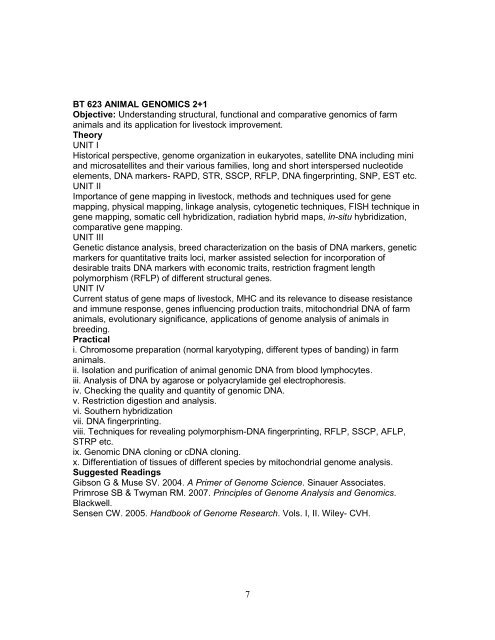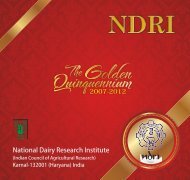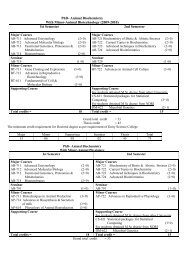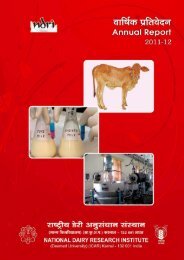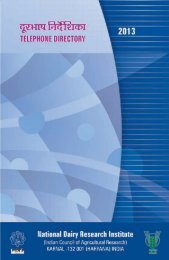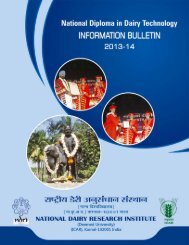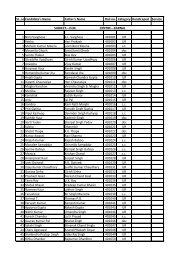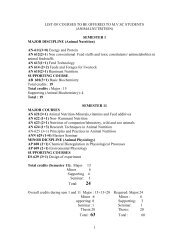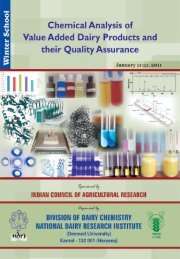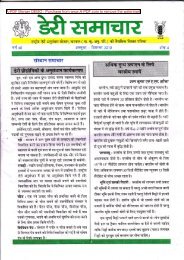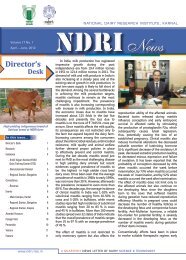ANIMAL BIOTECHNOLOGY Course Structure – at a Glance for M.Sc ...
ANIMAL BIOTECHNOLOGY Course Structure – at a Glance for M.Sc ...
ANIMAL BIOTECHNOLOGY Course Structure – at a Glance for M.Sc ...
Create successful ePaper yourself
Turn your PDF publications into a flip-book with our unique Google optimized e-Paper software.
BT 623 <strong>ANIMAL</strong> GENOMICS 2+1<br />
Objective: Understanding structural, functional and compar<strong>at</strong>ive genomics of farm<br />
animals and its applic<strong>at</strong>ion <strong>for</strong> livestock improvement.<br />
Theory<br />
UNIT I<br />
Historical perspective, genome organiz<strong>at</strong>ion in eukaryotes, s<strong>at</strong>ellite DNA including mini<br />
and micros<strong>at</strong>ellites and their various families, long and short interspersed nucleotide<br />
elements, DNA markers- RAPD, STR, SSCP, RFLP, DNA fingerprinting, SNP, EST etc.<br />
UNIT II<br />
Importance of gene mapping in livestock, methods and techniques used <strong>for</strong> gene<br />
mapping, physical mapping, linkage analysis, cytogenetic techniques, FISH technique in<br />
gene mapping, som<strong>at</strong>ic cell hybridiz<strong>at</strong>ion, radi<strong>at</strong>ion hybrid maps, in-situ hybridiz<strong>at</strong>ion,<br />
compar<strong>at</strong>ive gene mapping.<br />
UNIT III<br />
Genetic distance analysis, breed characteriz<strong>at</strong>ion on the basis of DNA markers, genetic<br />
markers <strong>for</strong> quantit<strong>at</strong>ive traits loci, marker assisted selection <strong>for</strong> incorpor<strong>at</strong>ion of<br />
desirable traits DNA markers with economic traits, restriction fragment length<br />
polymorphism (RFLP) of different structural genes.<br />
UNIT IV<br />
Current st<strong>at</strong>us of gene maps of livestock, MHC and its relevance to disease resistance<br />
and immune response, genes influencing production traits, mitochondrial DNA of farm<br />
animals, evolutionary significance, applic<strong>at</strong>ions of genome analysis of animals in<br />
breeding.<br />
Practical<br />
i. Chromosome prepar<strong>at</strong>ion (normal karyotyping, different types of banding) in farm<br />
animals.<br />
ii. Isol<strong>at</strong>ion and purific<strong>at</strong>ion of animal genomic DNA from blood lymphocytes.<br />
iii. Analysis of DNA by agarose or polyacrylamide gel electrophoresis.<br />
iv. Checking the quality and quantity of genomic DNA.<br />
v. Restriction digestion and analysis.<br />
vi. Southern hybridiz<strong>at</strong>ion<br />
vii. DNA fingerprinting.<br />
viii. Techniques <strong>for</strong> revealing polymorphism-DNA fingerprinting, RFLP, SSCP, AFLP,<br />
STRP etc.<br />
ix. Genomic DNA cloning or cDNA cloning.<br />
x. Differenti<strong>at</strong>ion of tissues of different species by mitochondrial genome analysis.<br />
Suggested Readings<br />
Gibson G & Muse SV. 2004. A Primer of Genome <strong>Sc</strong>ience. Sinauer Associ<strong>at</strong>es.<br />
Primrose SB & Twyman RM. 2007. Principles of Genome Analysis and Genomics.<br />
Blackwell.<br />
Sensen CW. 2005. Handbook of Genome Research. Vols. I, II. Wiley- CVH.<br />
7


